英国reference格式
- 格式:docx
- 大小:16.72 KB
- 文档页数:1
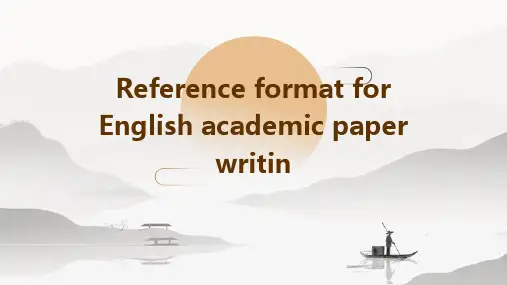
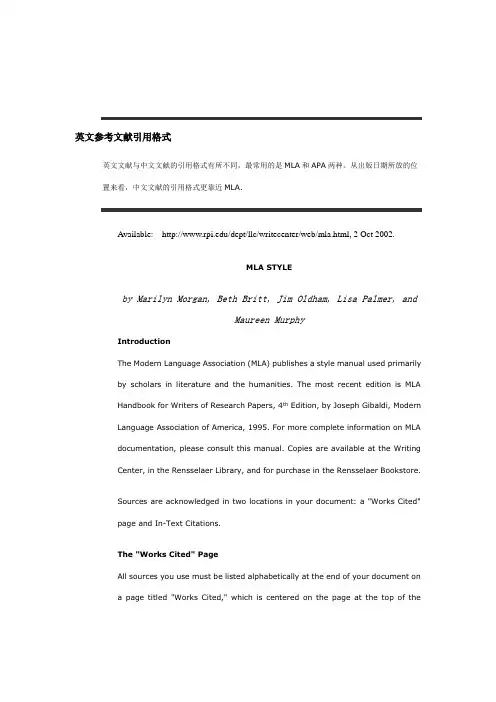
英文参考文献引用格式英文文献与中文文献的引用格式有所不同,最常用的是MLA和APA两种。
从出版日期所放的位置来看,中文文献的引用格式更靠近MLA.Available: /dept/llc/writecenter/web/mla.html, 2 Oct 2002.MLA STYLEby Marilyn Morgan, Beth Britt, Jim Oldham, Lisa Palmer, andMaureen MurphyIntroductionThe Modern Language Association (MLA) publishes a style manual used primarilyby scholars in literature and the humanities. The most recent edition is MLAHandbook for Writers of Research Papers, 4th Edition, by Joseph Gibaldi, ModernLanguage Association of America, 1995. For more complete information on MLAdocumentation, please consult this manual. Copies are available at the WritingCenter, in the Rensselaer Library, and for purchase in the Rensselaer Bookstore.Sources are acknowledged in two locations in your document: a "Works Cited"page and In-Text Citations.The "Works Cited" PageAll sources you use must be listed alphabetically at the end of your document ona page titled "Works Cited," which is centered on the page at the top of thedocument. The listing begins two lines down from this title; each citation is single spaced, but a double space is used to separated citations, thus:Works CitedAuthor’s last name, first name and middle name or initial (ifany).Book Title (underlined or italicized). City of publication: Publishers,Date of publication.Next author’s last name, first name and middle name orinitial (if any).Book Title(underlined or italicized). City of publication: Publishers,Date of publication.The citations are not numbered. Each citation begins with a hanging indent, which means that the second and following lines of each entry are indented five spaces under the first.Materials from different kinds of sources, such as journal articles, books and the Internet, are cited in slightly different ways.Examples:Citing a BookFormat:Author’s last name, first name and middle name or initial (if any). Book Title (underlined or italicized). City of publication: Publishers, Date of publication.Example:Gates, Henry Louis, Jr. Loose Canons: Notes on the Culture Wars. Oxford UP, 1992.Citing a Journal ArticleFormat:Author’s last name, first name and middle name or initial (if any). "Title of the article in quotation marks." Name of the Journal(underlined or italicized), Volume number, (Year): page numbers for the entire article.Example:Williams, Joan G. "Accelerated Fault Simulation: A Deductive Approach." Circuits Quarterly, 9 (1992): 212-220.Citing the InternetFormat:Author’s last name, first name and middle name or initial (if any). Descriptor or "Title of article in quotations marks." Internet. (Date the article was posted, if given.)Available: Internet address. Date you accessed the material.Example:Honeycutt, Lee. Communication and Design Course Web Site. Internet. (1997) Available: /commdesign/class1.html, Jan. 1998.Citing a ChapterFormat:Author’s last name, first name and middle name or initial (if any). "Title of the chapter in quotation marks." In Book Title(underlined or italicized). First, middle and last name of the editor, Ed. City of publication: Publishers, Date of publication, pages on which the chapter appears.Example:Fraser, Kathleen. " The Tradition of Marginality." In Where We Stand: Women Poets on Literary Tradition. Sharon Bryan, Ed. NY: W.W. Norton, 1993, 52-65.Citing a Book with more than one authorFormat:First author’s last name, first name and middle name or initial (if any) andsecond author’s first, middle, and last name. Book Title (underlined oritalicized). City of publication: Publishers, Date of publication.Example:Gilbert, Sandra M. and Susan Gubar. The Madwoman in the Attic: TheWoman Writer and the Nineteenth-Century Imagination. New Haven:Yale UP, 1979.In-text CitationsAny material in your document which derives from other sources whether bydirect quotation, paraphrase, or inspiration must be attributed immediately andthe sources named either by direct reference or by parenthetical citation.Direct ReferenceIf it can be smoothly done, sources may be cited directly in your text.Examples:In a stunning scene on page 27, Bronte reveals the source ofHeathcliff’s inner torment: "in an uncontrollable passion oftears [ , ] ‘Come in! come in!’he sobbed. ‘Cathy do come.’"According to Henry Louis Gates, "[ r ]ace is the ultimatetrope of difference" (49).Any information not given directly in the text, must be cited parenthetically (within parentheses).Parenthetical CitationA parenthetical citation must include (if not already given) the first word of the listing of the source on the works-cited page (most usually the author’s last name) and, in the case of paraphrase or quotation, the number of the page on which the material originally appeared.Example:To at least one American scholar, "[ r ]ace is the ultimate trope ofdifference" (Gates 49).In a parenthetical citation, no punctuation separates the naming of the source ant the page number.The title of the work cited need not be named unless you are using two different works by the same author, in which case you would then, in addition to the author, indicate the first word of the title of the specific reference you are making: Example: (Gates, Loose 49).A page number need not be used if you have used an idea more generally contained within the source material, but which you have neither quoted nor paraphrased.Example:The word "race" has been used to reduce people to sociallyconstructed categories (Gates).The period follows the parenthesis unless you are using a block quotation. Block QuotationIf the quotation you are using consists of more than three lines of text, you need to use a block quotation. To accomplish this, indent the lines of quoted text from both the right and left margins.If your document is double spaced, the block quotation is double space as well. Example:Yet consciousness is also an end in itself. Long traditions ofworking-class self-activity have properly focused on concretematerial gains or desired structures of social organization, butonly as instruments for enduring alienation and for promotingdemocracy and justice. (Lipsitz 128)In a block quotation, the period marking the end of the quotation precedes the parenthesis.。
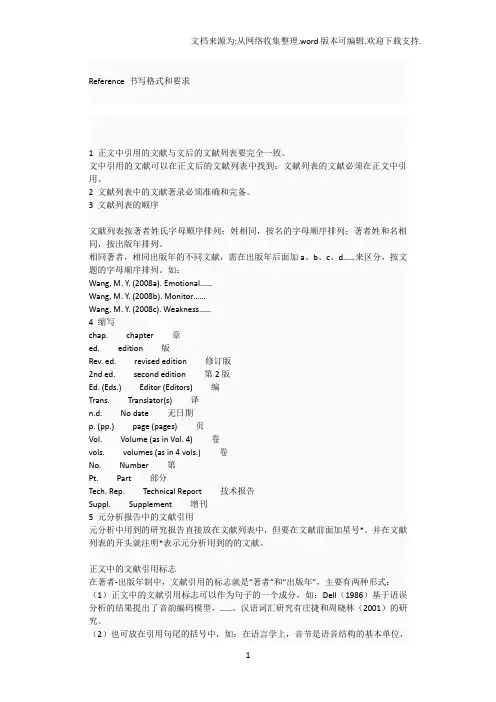
Reference 书写格式和要求1 正文中引用的文献与文后的文献列表要完全一致。
文中引用的文献可以在正文后的文献列表中找到;文献列表的文献必须在正文中引用。
2 文献列表中的文献著录必须准确和完备。
3 文献列表的顺序文献列表按著者姓氏字母顺序排列;姓相同,按名的字母顺序排列;著者姓和名相同,按出版年排列。
相同著者,相同出版年的不同文献,需在出版年后面加a、b、c、d……来区分,按文题的字母顺序排列。
如:Wang, M. Y. (2008a). Emotional……Wang, M. Y. (2008b). Monitor……Wang, M. Y. (2008c). Weakness……4 缩写chap. chapter 章ed. edition 版Rev. ed. revised edition 修订版2nd ed. second edition 第2版Ed. (Eds.) Editor (Editors) 编Trans. Translator(s) 译n.d. No date 无日期p. (pp.) page (pages) 页Vol. Volume (as in Vol. 4) 卷vols. volumes (as in 4 vols.) 卷No. Number 第Pt. Part 部分Tech. Rep. Technical Report 技术报告Suppl. Supplement 增刊5 元分析报告中的文献引用元分析中用到的研究报告直接放在文献列表中,但要在文献前面加星号*。
并在文献列表的开头就注明*表示元分析用到的的文献。
正文中的文献引用标志在著者-出版年制中,文献引用的标志就是“著者”和“出版年”,主要有两种形式:(1)正文中的文献引用标志可以作为句子的一个成分,如:Dell(1986)基于语误分析的结果提出了音韵编码模型,……。
汉语词汇研究有庄捷和周晓林(2001)的研究。
(2)也可放在引用句尾的括号中,如:在语言学上,音节是语音结构的基本单位,也是人们自然感到的最小语音片段。
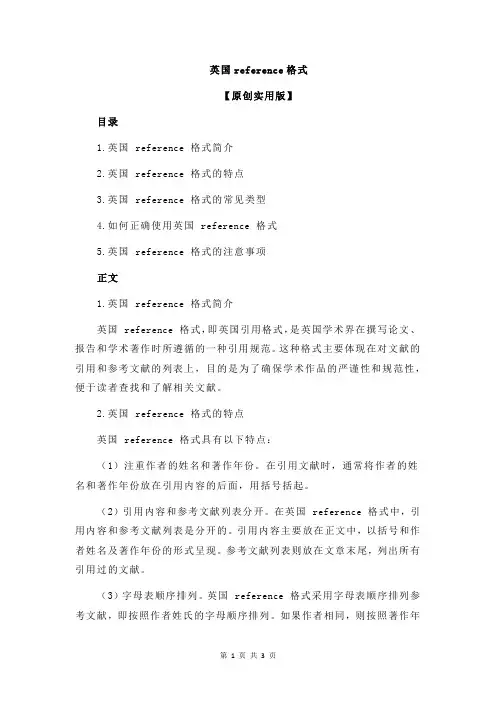
英国reference格式【原创实用版】目录1.英国 reference 格式简介2.英国 reference 格式的特点3.英国 reference 格式的常见类型4.如何正确使用英国 reference 格式5.英国 reference 格式的注意事项正文1.英国 reference 格式简介英国 reference 格式,即英国引用格式,是英国学术界在撰写论文、报告和学术著作时所遵循的一种引用规范。
这种格式主要体现在对文献的引用和参考文献的列表上,目的是为了确保学术作品的严谨性和规范性,便于读者查找和了解相关文献。
2.英国 reference 格式的特点英国 reference 格式具有以下特点:(1)注重作者的姓名和著作年份。
在引用文献时,通常将作者的姓名和著作年份放在引用内容的后面,用括号括起。
(2)引用内容和参考文献列表分开。
在英国 reference 格式中,引用内容和参考文献列表是分开的。
引用内容主要放在正文中,以括号和作者姓名及著作年份的形式呈现。
参考文献列表则放在文章末尾,列出所有引用过的文献。
(3)字母表顺序排列。
英国 reference 格式采用字母表顺序排列参考文献,即按照作者姓氏的字母顺序排列。
如果作者相同,则按照著作年份排序。
3.英国 reference 格式的常见类型英国 reference 格式有多种类型,其中较为常见的有:(1)哈佛格式(Harvard Style):在正文中引用文献时,将作者姓名和著作年份放在引用内容的括号内。
参考文献列表放在文章末尾,按照字母表顺序排列。
(2)牛津格式(Oxford Style):在正文中引用文献时,将作者姓名和著作年份放在引用内容的后面,用逗号分隔。
参考文献列表放在文章末尾,按照字母表顺序排列。
4.如何正确使用英国 reference 格式(1)在正文中引用文献在正文中引用文献时,将作者姓名和著作年份放在引用内容的括号内。
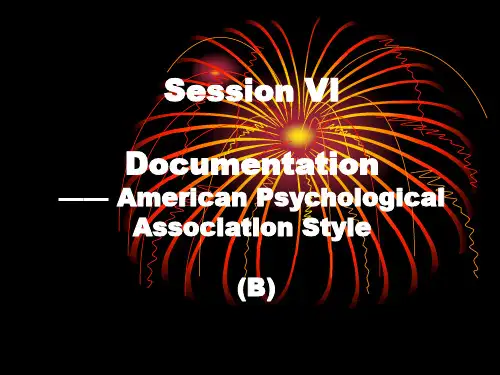
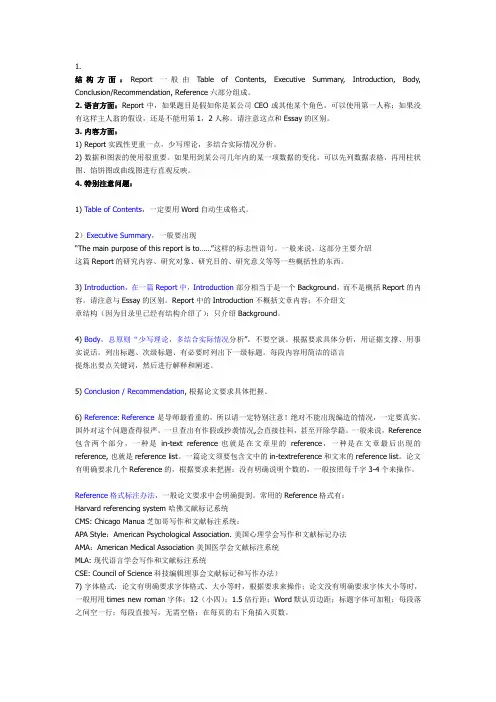
1.结构方面:Report一般由Table of Contents, Executive Summary, Introduction, Body, Conclusion/Recommendation, Reference六部分组成。
2. 语言方面:Report中,如果题目是假如你是某公司CEO或其他某个角色,可以使用第一人称;如果没有这样主人翁的假设,还是不能用第1,2人称。
请注意这点和Essay的区别。
3. 内容方面:1) R eport实践性更重一点,少写理论,多结合实际情况分析。
2) 数据和图表的使用很重要。
如果用到某公司几年内的某一项数据的变化,可以先列数据表格,再用柱状图、馅饼图或曲线图进行直观反映。
4. 特别注意问题:1) Table of Contents,一定要用Word自动生成格式。
2)Executive Summary,一般要出现“The main purpose of this report is to……”这样的标志性语句。
一般来说,这部分主要介绍这篇Report的研究内容、研究对象、研究目的、研究意义等等一些概括性的东西。
3) Introduction,在一篇Report中,Introduction部分相当于是一个Background,而不是概括R eport的内容。
请注意与Essay的区别。
Report中的Introduction不概括文章内容;不介绍文章结构(因为目录里已经有结构介绍了);只介绍Background。
4) Body,总原则“少写理论,多结合实际情况分析”,不要空谈。
根据要求具体分析,用证据支撑、用事实说话。
列出标题、次级标题、有必要时列出下一级标题。
每段内容用简洁的语言提炼出要点关键词,然后进行解释和阐述。
5) Conclusion / R ecommendation, 根据论文要求具体把握。
6) R eference: R eference是导师最看重的,所以请一定特别注意!绝对不能出现编造的情况,一定要真实。
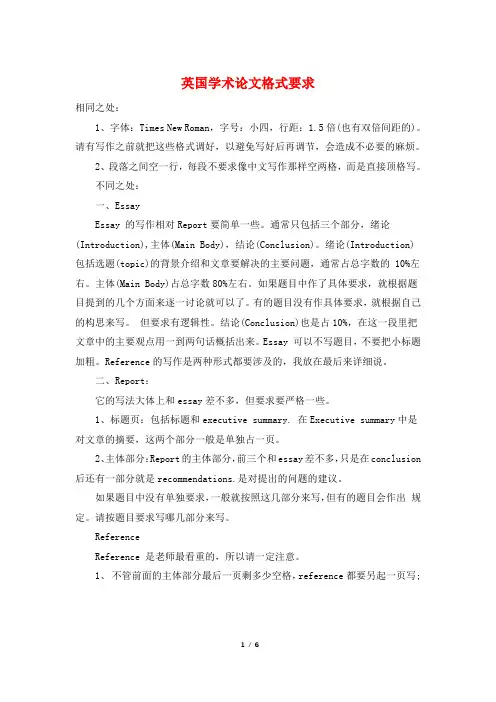
英国学术论文格式要求相同之处:1、字体:Times New Roman,字号:小四,行距:1.5倍(也有双倍间距的)。
请有写作之前就把这些格式调好,以避免写好后再调节,会造成不必要的麻烦。
2、段落之间空一行,每段不要求像中文写作那样空两格,而是直接顶格写。
不同之处:一、EssayEssay 的写作相对Report要简单一些。
通常只包括三个部分,绪论(Introduction),主体(Main Body),结论(Conclusion)。
绪论(Introduction)包括选题(topic)的背景介绍和文章要解决的主要问题,通常占总字数的 10%左右。
主体(Main Body)占总字数80%左右。
如果题目中作了具体要求,就根据题目提到的几个方面来逐一讨论就可以了。
有的题目没有作具体要求,就根据自己的构思来写。
但要求有逻辑性。
结论(Conclusion)也是占10%,在这一段里把文章中的主要观点用一到两句话概括出来。
Essay 可以不写题目,不要把小标题加粗。
Reference的写作是两种形式都要涉及的,我放在最后来详细说。
二、Report:它的写法大体上和essay差不多,但要求要严格一些。
1、标题页:包括标题和executive summary. 在Executive summary中是对文章的摘要,这两个部分一般是单独占一页。
2、主体部分:Report的主体部分,前三个和essay差不多,只是在conclusion 后还有一部分就是recommendations.是对提出的问题的建议。
如果题目中没有单独要求,一般就按照这几部分来写,但有的题目会作出规定。
请按题目要求写哪几部分来写。
ReferenceReference 是老师最看重的,所以请一定注意。
1、不管前面的主体部分最后一页剩多少空格,reference都要另起一页写;2、每条reference之间要空一行。
如果一条reference一排写不完,那么下面的几排提行时要和第一排三格。
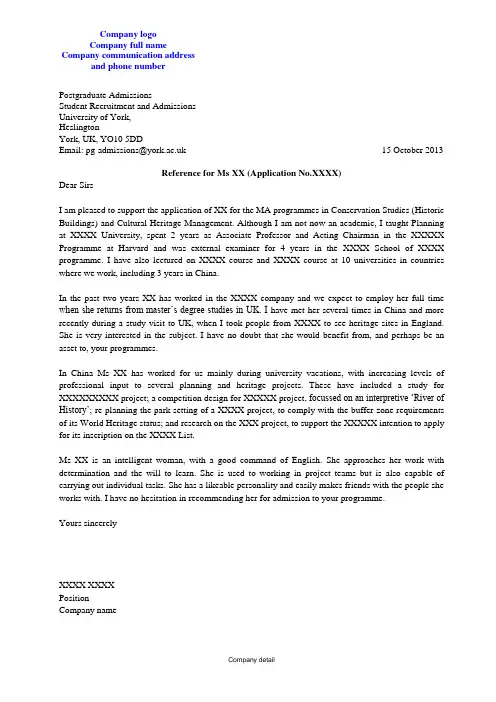
Company logoCompany full nameCompany communication addressand phone numberPostgraduate AdmissionsStudent Recruitment and AdmissionsUniversity of York,HeslingtonYork, UK, YO10 5DDEmail: pg-admissions@ 15 October 2013Reference for Ms XX (Application No.XXXX)Dear SirsI am pleased to support the application of XX for the MA programmes in Conservation Studies (Historic Buildings) and Cultural Heritage Management. Although I am not now an academic, I taught Planning at XXXX University, spent 2 years as Associate Professor and Acting Chairman in the XXXXX Programme at Harvard and was external examiner for 4 years in the XXXX School of XXXX programme. I have also lectured on XXXX course and XXXX course at 10 universities in countries where we work, including 3 years in China.In the past two years XX has worked in the XXXX company and we expect to employ her full time when she returns from master’s degree studies in UK. I have met her several times in China and more recently during a study visit to UK, when I took people from XXXX to see heritage sites in England. She is very interested in the subject. I have no doubt that she would benefit from, and perhaps be an asset to, your programmes.In China Ms XX has worked for us mainly during university vacations, with increasing levels of professional input to several planning and heritage projects. These have included a study for XXXXXXXXX project; a competition design for XXXXX project, focussed on an interpretive ‘River of History’; re-planning the park setting of a XXXX project, to comply with the buffer zone requirements of its World Heritage status; and research on the XXX project, to support the XXXXX intention to apply for its inscription on the XXXX List.Ms XX is an intelligent woman, with a good command of English. She approaches her work with determination and the will to learn. She is used to working in project teams but is also capable of carrying out individual tasks. She has a likeable personality and easily makes friends with the people she works with. I have no hesitation in recommending her for admission to your programme.Yours sincerelyXXXX XXXXPositionCompany nameCompany detail。
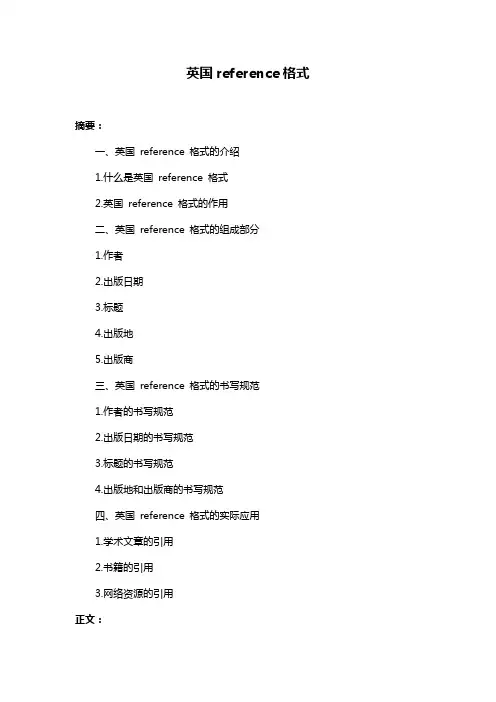
英国reference格式摘要:一、英国reference 格式的介绍1.什么是英国reference 格式2.英国reference 格式的作用二、英国reference 格式的组成部分1.作者2.出版日期3.标题4.出版地5.出版商三、英国reference 格式的书写规范1.作者的书写规范2.出版日期的书写规范3.标题的书写规范4.出版地和出版商的书写规范四、英国reference 格式的实际应用1.学术文章的引用2.书籍的引用3.网络资源的引用正文:在英国的学术界,reference 格式是论文、报告等写作中不可或缺的一部分。
它能够为读者提供文章中所引用的信息的来源,帮助读者进一步了解相关内容,同时也是对原作者的尊重和致谢。
英国reference 格式包括作者、出版日期、标题、出版地和出版商等部分。
首先,作者的书写规范是重要的。
通常,我们需要写出作者的全名,如果有两位作者,则两位作者的名字都需要写出来。
如果有三位或三位以上的作者,我们只需要写出第一个作者的名字,然后用“等”来表示。
其次,出版日期的书写规范也非常重要。
出版日期通常放在作者名字的后面,用小括号括起来。
例如:“张三,2021”。
标题是文章的核心内容,我们需要写出完整的标题,包括副标题。
如果有书名号或者引号,我们需要将它们也包括在标题中。
出版地和出版商的书写规范也是必不可少的。
出版地需要写明城市和国家的名称,而出版商则需要写出全名。
在实际应用中,英国reference 格式被广泛应用于学术文章的引用、书籍的引用以及网络资源的引用等。
正确的引用格式不仅能提高文章的质量,还能体现出作者的严谨态度。
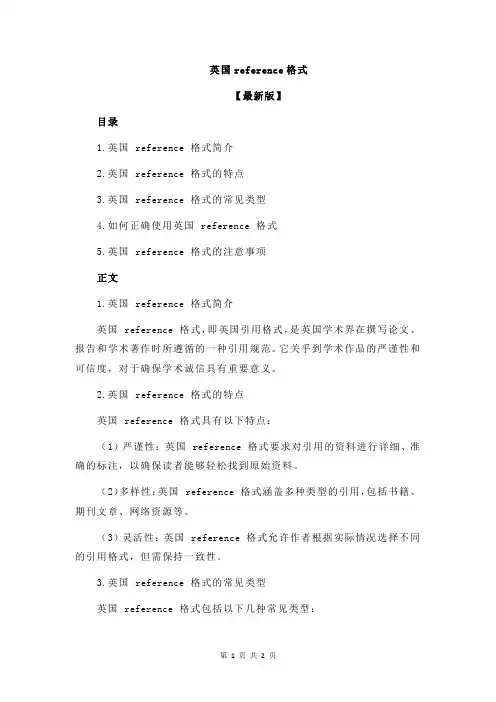
英国reference格式【最新版】目录1.英国 reference 格式简介2.英国 reference 格式的特点3.英国 reference 格式的常见类型4.如何正确使用英国 reference 格式5.英国 reference 格式的注意事项正文1.英国 reference 格式简介英国 reference 格式,即英国引用格式,是英国学术界在撰写论文、报告和学术著作时所遵循的一种引用规范。
它关乎到学术作品的严谨性和可信度,对于确保学术诚信具有重要意义。
2.英国 reference 格式的特点英国 reference 格式具有以下特点:(1)严谨性:英国 reference 格式要求对引用的资料进行详细、准确的标注,以确保读者能够轻松找到原始资料。
(2)多样性:英国 reference 格式涵盖多种类型的引用,包括书籍、期刊文章、网络资源等。
(3)灵活性:英国 reference 格式允许作者根据实际情况选择不同的引用格式,但需保持一致性。
3.英国 reference 格式的常见类型英国 reference 格式包括以下几种常见类型:(1)书籍引用格式:作者。
书名 [M].出版地:出版社,出版年:页码。
(2)期刊文章引用格式:作者。
文章题目 [J].期刊名称,年份,卷号 (期号):页码。
(3)网络资源引用格式:作者。
资源标题 [N/OL].网址:访问日期。
4.如何正确使用英国 reference 格式在使用英国 reference 格式时,应注意以下几点:(1)始终保持引用格式的一致性,避免在同一篇文章中混用不同格式。
(2)确保所引用的资料是权威、可靠的,避免引用未经证实的信息。
(3)对于直接引用的原文,需用引号标明,并注明出处。
(4)在文章中适当使用引用,以避免过度引用或抄袭。
5.英国 reference 格式的注意事项在使用英国 reference 格式时,需注意以下几点:(1)遵循学术诚信原则,切勿抄袭他人作品。

apa格式reference例子APA格式Reference例子在学术写作中,参考文献是一个重要的部分,它能够为读者提供支持和扩展资料来源的信息。
美国心理学协会(American Psychological Association,简称APA)制定了一套规范,用于对参考文献进行格式化。
以下是一些常见的APA格式Reference例子及其详细讲解:图书(Book)•书本–姓,名(出版年)。
书名。
出版地:出版社。
例子:Smith, J. D. (2019). The Art of Writing: A Comprehensive Guide. New York, NY: ABC Publishing.这个例子是一个单一作者的书。
作者的姓氏为Smith,名字为J. D. 书的出版年为2019年,书名为”The Art ofWriting: A Comprehensive Guide”,出版地为New York, NY,出版社为ABC Publishing。
•编辑书–编者的姓,名(Eds.)。
(出版年)。
书名。
出版地:出版社。
例子:Johnson, A., & Thompson, B. (Eds.). (2018).The Handbook of Writing. Los Angeles, CA: XYZ Publishing.这个例子是一本已经被编辑好的书。
编者的姓氏分别是Johnson和Thompson。
书的出版年为2018年,书名为”TheHandbook of Writing”,出版地为Los Angeles, CA,出版社为XYZ Publishing。
期刊文章(Journal Article)•期刊文章(印刷版)–作者姓,名(出版年)。
文章标题。
期刊名,期刊号(卷号),页码范围。
例子:Miller, R. (2020). The Impact of Writing on Cognitive Development. Journal of Child Psychology,12(3), 45-62.这个例子是一篇印刷版的期刊文章。
Harvard格式是我们留学生论文写作最常见的格式,尤其是在英国。
Harvard格式由两部分组成:文中文献出处(in-text reference)和文后参考文献目录(reference list),今天小编就先给大家整理一下in-text referencing的写作范方法,后续会在另外开文为大家讲述reference list的写作方法,希望大家持续支持我们。
In-text referencing:在文中一旦提及他人的观点,就应注明文献出处,格式为:(作者姓,出版时间)Reference list:所有文中(In-text)提到的参考文献在文后都要将其详细信息列出来。
下面我们先来看看In-text reference。
基本格式:(姓,出版年)Tips:外国人名的组成部分为,第一部分是名(first name),最后一部分是姓(family name),其他中间的全部是middle name。
所以大家在引用时,找到作者名字中最后的部分,就是他的姓了。
姓在任何情况下都不能缩写。
情况一:有作者一个作者:列出作者姓;(Gibson,2005).两个作者:列出两个作者的姓;(Gibson&Myers,2005).三个作者:列出所有作者姓,后面的两个作者姓用&连接;(MacLennan,Myers&Taylor,2005).四个作者或以上:只列出第一个作者的姓,其他作者用et al.替代;(Bair et al.2005).小编看到一些同学在引用三个作者的时候就用上了et al.代替这个是非常错误的。
情况二:没有作者1.当引用观点时不知道观点的作者是谁,可以用'Anonymous'或'Anon'代替;Marketing strategy(Anon.,1999).2.用书名、文章名或网页名替代;(BBC,2005),(Tesco,2005).直接引用原文句子:需指出句子出自的页码;(Schein,1997,p.20).同一处引用多个文献:用分号分隔各引文,并按作者、年、标题排序(Adams et al.,2003;MacLennan,Myers&Taylor,2006)。
最齐全的HarvardReference格式引用指南---英国翰思教育英国留学的小伙伴们都知道大部分学校都是使用Harvard(哈佛)Reference格式,今天hansedu就为你整理了最全的哈佛(Harvard)格式引用指南,接下去看吧!哈佛reference格式引用:参考List是创建工作时使用的所有资源的完整列表。
这份清单包括作者的来源,出版日期,来源的标题等信息。
哈佛参考Reference必须:在文件末尾的单独一页上,作者按字母顺序排列,除非没有作者,则按照源标题排序,如果同一作者有多个作品按日期排序,如果作品在同一年,则标题按字母顺序排列,并在日期之后分配一个字母(a,b,c等)双重间隔:每行文本之间应该有一个完整的空白行,包含所有使用的文本引用的完整引用。
哈佛(Harvard)Reference格式引用:正文在使用来自另一件作品的引用或释义之后,必须包含正文引用。
文本中的引用是在文本正文中的引用或释义,它们比完整的参考文献短得多。
在参考文献列表中显示了文中引文的完整参考文献。
在哈佛大学的引用中,正文引用包含作者或编辑的姓氏,出版年份和页码。
两三个作者:当引用两三位作者的来源时,请列出所有的姓氏;四个或更多作者:在这种情况下,第一作者的姓氏应该用“et al”来表示;没有作者:如果可能,请使用负责该职位的组织来代替作者。
如果不是,请使用斜体标题:(引文指南,2017,pp。
189-201)同一作者的多件作品:如果引用同一年发行的一位作者的多部作品,那么在一年之后,作品会被分配一封信(a,b,c等)。
这个分配是在参考清单中完成的,所以根据作者的姓氏和来源标题按字母顺序完成;一个括号中引用多个作品:以正常方式列出文本内引用,但在不同引用之间使用分号;在一个圆括号中引用不同版本的相同工作:包括作者的名字只有一次,后面跟着用分号隔开的所有适当的日期;引用没有日期的:在这种情况下,只需简单说出“无日期”来代替年份:(Mitchell,无日期,第189页)。
英文论文引用格式:HarvardReference格式----英国翰思教育Harvard Reference格式是英国学校学生用来写英文论文的一种引用格式;使用率相比其它引用格式较普遍一些。
那么如何使用Harvard Reference格式进行引用呢?Hansedu老师带你认识哈佛引用格式。
Harvard Reference格式包括两种类型:1. 直接引用或解释源时,使用正文引用;它们位于作品的正文中,并包含完整引用的片段。
根据来源类型的不同,哈佛大学参考文献中的一些引文可能如下所示:“After that I lived like a young rajah in all the capitals of Europe…”(Fitzgerald, 2004).2. 参考资料列表位于工作结束,显示完整的引用,用于分配中使用的来源。
以下是哈佛参考书目中一本书的完整引用例子:Fitzgerald, F. (2004). The great Gatsby. New York: Scribner.Harvard Reference格式参考列表是为了让读者自己定位原始资料而创建的。
引用列表中的每个引用包括各种信息,包括:作者姓名发表年份标题城市出版出版者引用内容的页码通常,哈佛参考文献列表引用遵循以下格式:姓,首字母。
(发表年份)标题。
城市:出版商,页面。
引文按照作者姓氏的字母顺序列出。
如果同一作者有多个来源,则在出版之日前按照顺序列出引文。
引用两个或两个以上作者的书的Harvard格式引用具有多个作者的引文时,请按照它们在来源上的显示顺序进行排列。
用“和”来分隔名字。
姓,首字母和姓氏,第一首。
(发表年份)标题。
城市:出版商,页面。
例:Desikan, S. and Ramesh, G. (2006). Software testing. Bangalore, India: Dorling Kindersley, p.156.Vermaat, M., Sebok, S., Freund, S., Campbell, J. and Frydenberg, M. (2014). Discovering computers. Boston: Cengage Learning, pp.446-448.Daniels, K., Patterson, G. and Dunston, Y. (2014). The ultimate student teaching guide. 2nd ed. Los Angeles: SAGE Publications, pp.145-151.Harvard Reference格式参考文献列表当同一作者有多件作品时,按年份排列引用次序。
英国Reference格式什么是Reference?在学术研究和写作中,引用文献是非常重要的一部分。
引用文献可以用于支持自己的观点,证明自己的观点有依据,并且向读者提供更多相关的信息。
在英国,引用文献的格式通常遵循特定的规范,被称为英国Reference格式。
为什么要使用英国Reference格式?使用英国Reference格式的好处是可以使读者更容易找到和了解你所引用的文献。
它提供了必要的信息,包括作者姓名、出版日期、标题等。
这样,读者可以根据这些信息去查找原始文献,进一步深入研究相关主题。
此外,使用英国Reference格式也有助于避免抄袭。
通过提供准确的引用,你可以明确地表明哪些部分是自己的观点,哪些是来自其他人的研究成果。
如何使用英国Reference格式?英国Reference格式通常包括以下几个要素:作者、出版年份、文章标题、期刊名称、卷号、页码。
以下是一个示例:Smith, J. (2010). The impact of climate change on biodiversity. Environmental Science, 25(3), 123-145.在这个示例中,Smith是作者的姓氏,J是作者的名字缩写。
出版年份是2010年。
文章标题是”The impact of climate change on biodiversity”。
期刊名称是Environmental Science。
卷号是25,期号是3。
页码是123-145。
注意,在英国Reference格式中,作者的姓氏在前,名字缩写在后。
如果有多位作者,可以用逗号分隔。
如何编写英国Reference格式?编写英国Reference格式时,需要根据具体的文献类型进行相应的调整。
以下是一些常见的文献类型和对应的格式要求:1.书籍:Smith, J. (2010). The impact of climate change on biodiversity. London: Academ ic Press.2.期刊文章:Smith, J. (2010). The impact of climate change on biodiversity. Environmental Science, 25(3), 123-145.3.学位论文:Smith, J. (2010). The impact of climate change on biodiversity (博士学位论文).University of Oxford.4.网络资源:Smith, J. (2010). The impact of climate change on biodiversity. Retrieved from[URL]以上仅为示例,具体的格式要求可能因学校、学科或期刊的要求而有所不同。
一.Reference的三种类型: 从书上引用,从杂志里的文章中引用,从网站引用1, 从书上引用的ref,格式:作者名字.年代.书名(斜体).出版社地址: 出版社名Example:Davidson, M. and Cooper, C. (1992). Shattering The Glass Ceiling: The Woman Manger. London: Paul Chapman.2, 从杂志里的文章中引用的ref,格式:作者名字.年代.文章名. 杂志名(斜体): 第几期, 页数Example:Pringle, J. (2004). Women Senior Managers: Successful Individuals Or Markers Of Collective Change. Women’s Studies Journal, 18, (2), 79-963,从网站引用的ref, 格式作者名字.年代.书名(斜体).Retrieved on年月日. from:网站Example:Adler, M. (2005). Women's Employment Concentrated In Service Industries. Retrieved on 20th September, 2005 from:.(注意: 网站另起一行)二, reference 的注意事项:1, 如果reference有两行或两行以上, 从第二行起,向内缩进五到七个字符Example:Rosener, J. (1995). America’s competitive secret: Utilizing women as a management strategy.USA: Oxford University Press.2, reference与reference中间要隔一行3文章名和杂志名:每个单词的首字母大写,虚词除外4,文章后面列出的所有reference必须与加进文章中的reference一一对应5, reference做完以后,以作者的首字为准,按字母顺序进行排列6,一般情况下,1000字,至少四个reference.这里需要强调一点:国外治学严谨,reference一定要做好!!我们的作业严禁直接抄书或从网上直接复制粘贴(这在国外被界定为抄袭)国外的学校有强大的数据库,抄袭的地方,数据库一搜就发现了一旦发现抄袭,轻则挂科,重则拿不到学位,诚信记录还要被写上一笔你可以翻译中文也可以用自己的话把句子转述一遍但是直接引用和一个句子只改2、3个单词是一样会被判抄袭的!To develop a community profile (社区分布)for one Australian Local Government Area (LGA) of your choice, (excluding the City of Boroondara) using data from the 2001 and 2006 Census available from the ABS website. The focus of the demographic profile will be to describe up to three cultural characteristics of the population within your chosen LGA, and look at changes that have occurred from 2001 to 2006.Examples of cultural characteristics are ancestry, birthplace, language spoken, year of arrival in Australia, religious affiliation, English proficiency, and indigenous status. You are expected to synthesise (综合)the information available, not just replicate (折叠,复制)the tables that you can download. For example, you may choose to group a Census table detailing individual birthplaces into categories, and then show the proportional distribution - not just the number by birthplace; or from Year of Arrival in Australia you may derive the number of years living in Australia. In other words, you are required to analyse and summarise the information you find into your own summary tables and charts. In your demographic profile you should include summary tables, charts and commentary to support the graphs and tables. You should make use of data from both the 2001 Census and the 2006 Census (e.g. using a combination QuickStats, MapStats and Census Tables.制定一个社会形象之一澳大利亚地方政府区(儿)您的选择,(不包括城市Boroondara )使用数据从2001年和2006年人口普查可从澳大利亚统计局的网站上。
英国ReportReference格式有哪些?英国大学向来以严谨的教学方式著名, 尤其是对于英国Report格式的要求,特别是Report引用格式, 毕竟引用不小心,就会有剽窃风险. 本期为大家详细讲解英国论文常见的引用格式以及使用规则等。
留学生在写Essay、Report或其它形式的学术写作时, 我们的想法不可避免地会与其他同学或者老师的过往研究有所重合. 所有新的研究都是“站在巨人的肩膀上”进行创作思考, 都是依靠无数前辈的研究而最终形成的. 因此, 我们必须在论文中正确使用参考文献的来源, 证明我们对参考文献有着深入的研究和思考, 同时也是对之前作者的尊敬。
准确的引用格式可以达到以下的目的:•将你的想法和发现与先前的研究区分开来•为论文中提到的想法和事实提供细节证据当然,参考文献引用格式并不是简单地把文献堆砌在你的论文中, 在我们引用某一篇文献或者理论之前, 首先需要理解文献的内容,考量它与论文主题的相关性. 只有理解了阅读文献背后的基本原理,才能把文献利用到你的论文中。
Reference本质上是参考文献的信息. 例如作者的名字、出版时间、出版地、期刊号等等. Reference一般出现在两个地方: 在论文的正文,就是我们常说的文内引用, Citation. 第二个地方是在论文最后出现的文献列表, 通常被称为Reference List或者Bibliography。
英国Report引用格式的第一步就是收集文献资料和记录笔记: 记下每个文献的完整出版信息, 这些细节应该包括: 作者姓名/出版日期/文字标题。
对于特别重要的要点或者逐字引用的部分文本, 还要在备注中包含页码。
英国Report参考文献格式:英国学术写作有很多种引用格式, 有的学校会指定首选的引用格式.目前在英国和美国最广泛使用的引用系统有以下几种:•Harvard: 哈佛大学与APA格式非常相似, 英国和澳大利亚最常使用Harvard参考文献引用格式。
英国reference格式
【实用版】
目录
1.英国 reference 格式的概述
2.英国 reference 格式的主要类型
3.英国 reference 格式的引用规则
4.英国 reference 格式的实例分析
正文
英国 reference 格式是指在英国学术写作中引用参考文献所遵循的一种规范。
这种格式主要用于规范学术文献的引用,以确保知识产权的尊重和保护,同时提高学术研究的可信度和严谨性。
英国 reference 格式主要有以下几种类型:
1.哈佛格式(Harvard Format):这种格式是英国最常用的引用格式,特点是在文献中引用时,作者姓名和出版年份放在方括号内,之间用逗号分隔。
例如:(Smith, 2015)。
2.温哥华格式(Vancouver Format):这种格式主要在医学领域使用,特点是在文献中引用时,作者姓名和出版年份放在圆括号内,之间用逗号分隔。
例如:(Johnson et al., 2018)。
3.牛津格式(Oxford Format):这种格式特点是在文献中引用时,只列出作者的姓氏,出版年份放在句末。
例如:Smith (2015) 指出。
在英国 reference 格式中,引用规则非常重要,主要包括以下几点:
1.引用文献时,必须确保文献的可查性,避免使用不可靠的来源。
2.引用文献的数量要适度,过多或过少都可能影响论文的质量。
3.引用文献时,要注意保持格式的一致性,遵循所选格式的要求。
4.引用文献时,要遵循版权规定,尊重原作者的知识产权。
下面是一个英国 reference 格式的实例分析:
在撰写一篇关于气候变化的论文时,我们需要引用相关研究成果。
例如,我们可以引用一篇名为“气候变化对全球农业的影响”的文章,作者是 Johnson, A.和 Smith, B.,发表于 2018 年。
在文中引用时,可以这样写:
气候变化对全球农业的影响日益严重 (Johnson & Smith, 2018)。
通过以上分析,我们可以了解到英国 reference 格式的特点和要求。
第1页共1页。